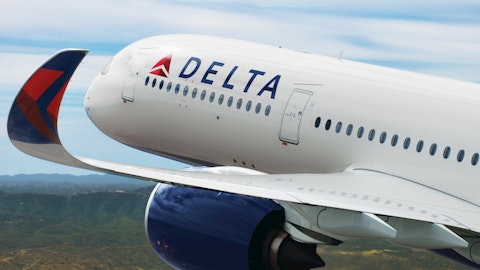So we only expect maybe three or so to come out of service in the next few years of that 14, but we sort of had some cliffs. As you may recall, they were the first 12 aircraft that sort of got the Amazon relationship started. They were the first 12 of what became 42 aircraft that we were leasing to Amazon, the other 30 are all the larger 76s. So they came to the end of their extended lease terms. And Amazon had an option to not – obviously not extend further as they had done a couple of times already with that fleet type. So that’s what you’re seeing. So I do think, as we look into next year, from a year-over-year basis, you’ll see less of a negative impact on CAM in comparing to prior periods because we had these chunks of 200s that we got back last year and this year.
And so I think that will stabilize as we look forward.
Christopher Stathoulopoulos: Okay. If I could just get in one more. So just remind us where you are with the labor talks with ATI and Omni? Thank you.
Joe Hete: Sure. As I mentioned earlier, Chris, that we had a mediation session last week with the folks at ATI and had one with the Omni folks a couple of weeks ago. Obviously, we’re still trying to work through the negotiations. I think if you look at what we agreed to with the ABX pilots, who weren’t in a position where the CBA was amendable, they stepped up and said, okay, look, here is what we think is reasonable. So, it kind of sets the market away for our line of business as opposed to, as I said earlier, we can’t compare ourselves to a FedEx or a UPS or anybody of that, it’s a totally different business environment. So, we still expect that we won’t get any of those done this particular year. If we do, that’s great.
And I think the fact that we were able to get something across the plate with the ABX guys, and realistically what took three days. So, the company can get there from here. It used to have and have to have realistic expectations on the other side of the table.
Christopher Stathoulopoulos: Okay. Thank you.
Joe Hete: Thank you.
Operator: Thank you. [Operator Instructions] Our next question comes from Michael Ciarmoli with Truist Securities. You may proceed.
Michael Ciarmoli: Hey. Good morning guys.
Joe Hete: Hi Michael.
Michael Ciarmoli: Nice results here. Thanks for taking the question. Just on this Amazon, I mean did you opt to use ABX because of the pilot settlement there and just thinking – I think you said what, you got to hire 50 pilots. Would that have been more of a challenge? Just I guess just how did the ABX come into play versus ATI?
Joe Hete: No, I think the key driver there was the fact that there was a new agreement, which basically the new hire rate that allowed us to get people onboard. One of the challenges we have had is what every other airline in the industry has had over the last 18 months to 24 months is finding sufficient pilots. And of course, key to that is what your starting rate is in that regard. So, with the new agreement, it made it easier for us to basically be able to onboard the people that we need necessary. One of the challenges that we have had on the ATI side of the equation is we don’t have enough guys to cover the left seat of the airplane, surprisingly enough. We have a lot of new hire first officers with basically not as much experience to be able to move to the left seat.
So, that presents challenges in terms of being able to staff up for the aircraft flying that we need to get done. And so the ABX option with the new agreement certainly made it easier for us to onboard the necessary people in the tight timeframe that we have. As we have mentioned, we have to get these aircraft into service by target is December 1st, and that’s a lot of airplanes to bring on when we won’t receive the first one until June.
Michael Ciarmoli: Right. Okay. Is the profitability on these planes the same, just probably assuming that there is more salary and wages on ABX versus ATI?
Joe Hete: Yes, every contract is different in terms of the cost structure. For example, with the ATI folks, they have home basing, which is a significant expense to the company to be able to move them to their first assignment, where the ABX guys are domiciled, so it’s their responsibility to get there. So, that keeps that side of the cost equation down. The other piece of it is, as I said, the amount of premium pay that we had to pay on the ATI side of the equation has had a negative impact on our earnings on that side. And so that’s what we have to overcome. And we think with the new agreement on the ABX side, that facilitates the hiring piece.
Michael Ciarmoli: Okay. Got it. And then just give me the background. Why did this new deal have to come with the $2.9 million of warrants? I mean I guess that’s at some point maybe 4% dilution. I am just trying to understand the mechanics behind this whole transaction and why the need? And then I guess there was a lot of different language in there regarding if you guys announced a buyback and what price Amazon can sell for, just if you can give us any color there.
Quint Turner: Yes. Michael, we – of course, we have done some different deals with Amazon, expansions and renewals. And it’s always a question of just looking at the value creation in any of these deals. I don’t think we are unique that Amazon, when they do significant deals, they may look to the equity side as part of that negotiation and the other party always just has to make an assessment what’s in the best interest and what creates the most value. It’s a negotiation point that does come up when you get into these kind of discussions.
Michael Ciarmoli: Okay. Got it. Thanks guys. I will jump back in the queue.
Joe Hete: Thanks.
Operator: Thank you. [Operator Instructions] Our next question comes from Isaac Sellhausen with Oppenheimer. You may proceed.



